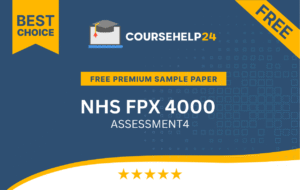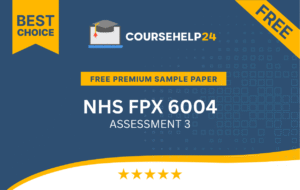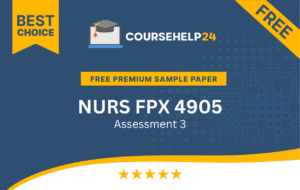NURS FPX 6011 Assessment 1: Evidence-Based Patient-Centered Needs Assessment
As the population ages overall, diabetes is becoming more common in those aged 65 and older. Among those aged 65 and older, the mortality rate from diabetes will be 33%. Diabetic problems, such as hypoglycemia (low blood sugar), renal failure, and heart disease, are more common in older adults than in younger people. Physicians may be better equipped to detect and treat diabetes in the elderly due to new and developing data. In order to improve health and quality of life, these variables should be taken into account. It is more challenging to teach and manage diabetes in the elderly due to their increased risk of cognitive decline, cardiovascular disease, and other ailments. The elderly require medication for hypertension, hyperlipidemia, and glucose control. Patients with diabetes who obtain self-management support are more likely to take their medications as directed, feel less stressed out by their illness, and have better health. It is uncertain if the SMS models are feasible, sustainable for primary care clinics, and acceptable to patients. Thus, as stated in NURS FPX 6011 Assessment 1, it is necessary to translate this study into practice.
The Importance of Addressing Patient Engagement in Diabetes Management
As chronic conditions like type 2 diabetes are managed, patient engagement is being recognized more and more as a factor in improving health behaviors and outcomes (Rutten et al., 2020). According to the evidence-based patient-centered concept map, patient participation is widely acknowledged as a crucial component of providing high-quality healthcare in the context of chronic illnesses. The importance of patient involvement in the treatment and management of type 2 diabetes, particularly in high-risk persons, has not decreased. According to patients with diabetes, whole-person-centered treatment led to higher levels of activity, a more positive outlook on diabetes, and a somewhat better clinical outcome (Rutten et al., 2020). Increased
patient participation may also be a feature of person-centered care. However, in light of NURS FPX 6011 Assessment 1, quick improvements in medical conditions must be reexamined. Superior medical results and reduced medical expenses are the direct results of patient engagement, which transforms patients into active partners in their care.
However, the risks to patients who are not involved are poor clinical outcomes and a waste of healthcare resources. According to the patient-centered concept map, involving patients in treatment planning and taking into account their values and preferences has improved services and results (Rutten et al., 2020). A common approach for older adults with diabetes is care coordination, which involves delivering social and health services in a customized, integrated way.
Diabetes management includes the idea of self-care for diabetics (Northwood et al., 2022). Because family members can play a major role in managing diabetes, involving them in the self-care process may improve the disease’s management. Self-management of type 2 diabetes is associated with better glucose control and reduces the risk of complications from the disease. One important factor in diabetes management is the patient’s social and familial support (Northwood et al., 2022). The interactions between families must always be taken into account when creating interventions in NURS FPX 6011 Assessment 1, since the majority of adolescent diabetes treatment takes place at home.
With a greater understanding of the role that engagement plays in promoting beneficial health behavior and clinical results, as evidenced by evidence-based concept maps, the healthcare industry is looking for innovative ways to enhance the individual’s role in the treatment process. To encourage patients to take an active role in their own care, Rutten et al. (2020) also recommend using a person-centered approach, which is recommended by both the
American Diabetes Association and the European Association for the Study of Diabetes. To do this, diabetics require diabetes education, self-assurance, skills, and motivation. The term “patient activation” is associated with the prerequisites. Since diabetic patients have a markedly increased risk of coronary heart disease, the patient-centered approach should include comprehensive plans to reduce the risk of heart attacks and strokes by addressing issues of hypertension and cholesterol levels, preventing and quitting smoking, managing weight, engaging in physical activities, and adopting appropriate lifestyle practices. The study evaluating the care coordination of elderly diabetic patients has produced encouraging findings (Northwood et al., 2022).. In order to identify the best practices, as described in the patient-centered care concept map, future research in this group should evaluate comprehensive healthcare planning, system navigation across the health and social care sectors, the role of healthcare coordinators and their relationship to patients, and caregiver support.
Use and Impacts of Information and Communication Tools
Technology advancements and the expansion of cost-optimization services have created new prospects for individuals with diabetes who are older (Doupis et al., 2020). Telemedicine services, made possible by the Internet and mobile devices, can greatly improve the communication between patients and healthcare providers. BlueStar is a diabetic counseling software that offers the same name on both iOS and Android devices. The FDA has approved this software as the first mobile prescription treatment app in the US. The BlueStar app allows patients to manually or wirelessly input their blood glucose levels into the app to receive real-time coaching (Doupis et al., 2020). They can also receive assistance in their medication schedule, and dietary and health advice. There are also other variables that are included, e.g., weight and blood pressure (Gurung and Neupaney, 2020). Moreover, the health practitioners can
send the patient over 25,000 automated coaching messages, personalized guidance, and progress reports. The number of mobile medical applications with a diabetes topic has dramatically increased during the last ten years. Basal and bolus insulin control are features seen in most commercial apps (Flors-Sidro et al., 2021). They provide automatic feedback based on the analysis of blood glucose trends in addition to a safe method of sharing data with other medical professionals.
Mobile phones, laptops, and personal computers are the most often utilized technological tools in self-management practices (Rutten et al., 2020). These devices would be used to access websites providing useful text, audio, or video information regarding diabetes. The diabetic patients can therefore easily cope with their disease independently. Just as this, mobile phone applications that measure the level of blood sugar in a non-clinical environment have also been useful in supplementing self-management measures. Continuous glucose monitors in wearable technology have increased in number in recent years. Bracelets, smart watches, skin patches, and even eye lenses are examples of wearable technology. As the patient-centered care concept map shows, these tools help people deal with their everyday situations, even though they may not be able to eliminate the need for ongoing care.
The utilization of information and communication technologies can assist in the enhancement of the health outcomes of diabetic elderly people by reducing the threats posed by low health literacy (Doupis et al., 2020). In the management of a chronic illness such as diabetes, several changes might be necessary, such as changes in medications, food, and other facets of daily living. Modern information and communication technology has helped a lot in treating elderly diabetics. One of the most recent studies suggests that individuals with diabetes who actively participate in their care may see better outcomes and experience fewer acute
complications (Gurung and Neupaney, 2020). With the aid of the many communication technologies and the highly developed communication tools in care management, the patients’ understanding of their illness and proactive measures is improved by the education and skills they have acquired. The burden of diabetes, which has already become inevitable, is being easily reduced by the growing use of online platforms and information and communication technology in healthcare. ICTs have led to patient-centered treatment, which encourages collaboration between healthcare professionals and senior diabetes patients. Additionally, it has made it possible to increase understanding and communication between the senior diabetic patients and the medical team. It is now proving to be a useful instrument for delivering high-quality medical treatment (Flors-Sidro et al., 2021). Patients over 65 will have a location to track their diabetes data and get tailored treatment recommendations.
As noted in NURS FPX 6011 Assessment 1, technological advancements like portals, cellphones, and mobile applications are opening up potential to improve access to and continuity of treatment for people with diabetes and other chronic diseases. However, it necessitates assessing and developing a variety of health-literate technologies. Although apps are useful for managing diabetes, it is unknown if they are also utilized to help people with type 1 diabetes (T1DM) safely drink alcohol. According to the patient-centered concept map, people with low health literacy will typically recognize and use tactics used by for-profit applications. Ways to improve the accessibility and usefulness of free diabetic mobile applications could be the subject of future study.
The value and relevance of the technology modalities
Users of iOS and Android devices can download the Diabetes Pal app (Gurung and Neupaney, 2020) to help manage their disease. As mentioned in NURS FPX 6011 Assessment 1, users can either manually enter their blood glucose levels or receive them wirelessly via
Bluetooth as read by their glucose meter. The doctor can check his or her patient’s blood sugar in real time with this telemedicine software (Watson, 2020). Additionally, it includes detailed guidelines on how to handle hypoglycemic cases. The management of diabetes in the elderly has become more easier and more automated with the advent of the newest telemedicine, web-based solutions, and mobile health applications (Gurung & Neupaney, 2020). In the past, a fingerstick blood sample was used to measure glucose levels. Nowadays, diabetic patients can check their blood sugar levels with a tiny wireless sensor that is implanted beneath their skin. This device sends data to the local computer network in a digital format. The outcome of this data is used to calculate the subcutaneous fluid’s glucose levels (Watson, 2020). By waving the reader over the sensor, certain sophisticated CGMs may also determine the blood sugar levels. The blood sugar level is tracked by following a light signal produced by a sensor.
A life-threatening drop in blood sugar levels can result from taking too much insulin, which is given to treat diabetes (Gurung & Neupaney, 2020). Recent advances in technology have made it possible to anticipate a decline in blood sugar and to instantly halt insulin transfers. Insulin pumps can be set up to release a predetermined amount of insulin, which can be manually changed to account for variations in the patient’s calorie intake. According to Gurung and Neupaney (2020), contemporary automated insulin pumps are closed-loop devices that employ an algorithm to track blood sugar levels and adjust insulin dosage at any moment. Although it is difficult to obtain a stable version of glucagon that can be utilized in the pump, completely accurate closed loop insulin and glucagon administration devices are now under development.
The patient should wear the pumps constantly even though they can assess blood sugar levels and give insulin (Watson, 2020). As noted in NURS FPX 6011 Assessment 1, a smart pen is an additional option to a tethered pump since it has all the characteristics of a pump, including
memory. Additionally, it uses Bluetooth and a smartphone app to record insulin dosages and times. Access to this data can be helpful for a number of diabetes monitoring applications. People with diabetes may have exercised more by playing movement-based video games. Numerous studies on type 1 diabetes in the aged population have led to the creation of a number of video games, including the Nintendo Wii Fit Plus. By carrying out specific tasks, such as determining the best way to give insulin, virtual and augmented reality can make self-management of care easier (Gurung and Neupaney, 2020). People can use it to find out how their blood sugar levels are affected by the foods they eat (via the glycemic index).
The degree to which the diabetic applications adhere to privacy and data security regulations is unknown. The results support the notion that more education should be given to physicians and patients on the privacy concerns associated with diabetic applications (Flors-Sidro et al., 2021). Thus, this study emphasizes the significance of sufficient and appropriate user training. The second piece of advice is that governments and regulatory agencies should strictly enforce data privacy laws. Establishing tighter security standards and procedures in Android and the Google Play Store, as well as involving and supervising all players in the application development process, are also crucial.
Innovative Strategies for Leveraging Telehealth
Palliative care nurses can use telephone-based methods to improve symptom monitoring and coping. Through a web-based method, it was discovered that cancer patients could benefit from the remote administration of medication. The patient’s diagnosis and the family’s needs must be used to determine the makeup of the multidisciplinary team (Gordon et al., 2022). Interprofessional approaches, which draw on the knowledge of several professions, offer a more thorough method of achieving the goals of client-centered care. Patients with diabetes will have
greater access to healthcare providers if they can be monitored and treated remotely through the use of an interprofessional approach.
Telehealth is widely used to address emotional distress and mental health issues. Telehealth-trained nurses help patients with spiritual or religious problems (Gordon et al., 2022). In the context of telehealth services, cultural considerations can be given priority because patients no longer need to travel great distances to receive care. For instance, a patient’s virtual visit or family reunion may also include family members and traditional healers. Telehealth services can be used to meet the health needs of indigenous communities and underdeveloped distant places. Remotely managing cancer patients with web-based technologies is quite successful. According to studies by Gordon et al. (2022), telehealth improved the standard of care and the management of symptoms like pain, hunger, and nausea. By completing online DNR/DN forms, advance directives, and health care proxies, patients are guided through the ethical and legal implications of their care.
The Mitigation of Adverse Risks With Proposed Strategies
A study found that the biggest obstacles to the widespread use of telehealth are patient data security and privacy (Dzau, Mate, and O’Kane, 2022). Because telehealth data is extremely sensitive, it is necessary to implement cutting-edge security solutions that can allay these worries. To reduce risks, security measures must be comprehensive. Because telehealth systems handle sensitive data, they must be especially secure under the HIPAA and HITECH Acts. The idea of protected health information (PHI) is one of the most crucial components of EMR, and HIPAA ensures the privacy and confidentiality of this data.
Using firewalls to safeguard healthcare organizations’ IT networks is the most often discussed security measure (Dzau, Mate, & O’Kane, 2022). Although firewalls have been shown
to be highly successful in protecting networks and PHI, their cost varies greatly depending on the size and scope of a business. Confidential data has been encrypted to protect electronic medical records. In this instance, encryption has improved the security of EHRs while they are being transferred between healthcare facilities (Dzau, Mate, & O’Kane, 2022). According to the patient-centered care concept map, the meaningful use constraints require that companies provide a standard format for sending medical records and track exchange information, such as whether encryption is being used or not.
The information that mobile agents may access can be encrypted and decrypted using safe techniques (Dzau, Mate, & O’Kane, 2022). When patients are being treated across institutions, mobile agents are protected, ensuring that electronic health data is both accessible and safe. The usage of a username and password is an additional encryption method. Users should regularly change their passwords to reduce the likelihood of security breaches, and passwords are regarded as sensitive information (Dzau, Mate, and O’Kane, 2022). Other than the user’s name or a significant date, the password must contain at least one other character. Using credentials like usernames and passwords, a provider can impose role-based constraints. Role-based access control makes it possible to access data using login credentials that have been provided by a system administrator. The actions prevent electronic health records (EHRs) from being accessed or altered without authorization (Dzau, Mate, and O’Kane, 2022). I will have to log out of the system at the end of each use as an employee in order to prevent unauthorized persons from gaining access. The role that cloud computing can play in collaborating and integrating with EHR systems has come into more prominence as technology has advanced. Because cloud computing has developed infrastructures that allow for the rental of storage, software, and processing power, data can be shared and saved digitally (Dzau, Mate, and O’Kane,
2022). According to NURS FPX 6011 Assessment 1, healthcare companies can reduce the cost of deploying an EHR system by using this platform to help shift ownership and maintenance costs. The cryptographic measures are offered to further ensure secure cloud access.





